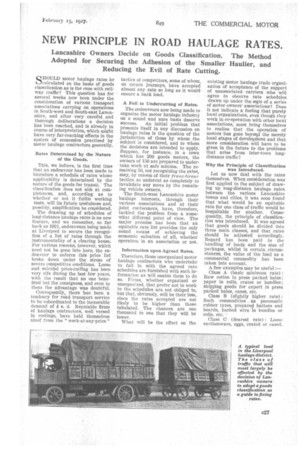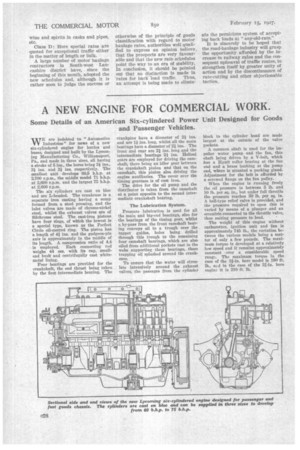NEW PRINCIPLE IN ROAD HAULAGE RATES.
Page 49

Page 50

If you've noticed an error in this article please click here to report it so we can fix it.
Lancashire Owners Decide on Goods Classification. The Method Adopted for Securing the Adhesion of the Smaller Haulier, and Reducing the Evil of Rate Cutting.
SIIOULD motor haulage rates be calculated on the basis of goods classification as is the case with railway traffic? This question has for several weeks now been under the consideration of various transport associations carrying on operations in South-west and South-east Lancashire, and after very careful and thorough deliberations a decision has been reached, and is already in course of interpretation, which might have very far-reaching effects in the system of economics practised by motor haulage contractors generally.
Rates Determined by the Nature of the Goods.
This, we believe, is the first time that an endeavour has been made to Introduce a schedule of rates whose applicability is determined by the nature of the goods for transit. The classification does not aim at completeness, and, according as to whether or not it fulfils working tests, will its future usefulness and, possibly, amplification be considered.
The drawing up of schedules of long-distance haulage rates is 110 new feature, and we remember, so far back as 1921, endeavours being made at Liverpool to secure the recognition of a list of rates through the instrumentality of a clearing house. For various reasons, however, which need not be gone into here, the endeavour to enforce this price list broke down under the stress of severe competitive conditions. Loose and suicidal price-cuffing has been very rife during the last few years, with the result that no one benefited but the consignees, and even to them the advantage was doubtful.
Consequently,, there has been a tendency for road transport service to be subordinated to the inexorable demand of 1 s. d. Reputable firms of haulage contractors, well versed in costings, have held themselves aloof from the "work-at-any-price " tactics of competitors, some of whom, on return journeys, have accepted almost any rate so long as it would ensure a back load.
A Foil to Undercutting of Rates.
The endeavours now being made to organize the motor haulage industry on a sound and sure basis deserve success. An initial problem that presents itself in any discussion on haulage rates is the question of the jurisdiction of those by whom the subject is considered, and to whom the decisions are intended to apply. Suppose, for instance, in a town which has 200 goods motors, the owners of 150 are prepared to undertake work at safe minima. The remaining 50, not recognizing the rates, may, by reason of their franc-tireur tactics, so undercut as completely to invalidate any move by the remaining vehicle owners.
The South-west Lancashire motor haulage interests, through their various associations and at their joint conferences, have, therefore, tackled the problem from a somewhat different point of view. The major premise has been that an equitable rate list provides the only sound means of achieving the economic salvation of all, whether operators in an association or not.
Information upon Agreed Rates.
Therefore, those unorganized motor haulage contractors who undertake to fall in with the agreed rate schedules are furnished with such information as will enable them to do so. Firms, whether organized or unorganized, that prefer not to work to the schedules are not obliged to, but that, obviously, will be their loss, since the rates accepted are not likely to be higher than those tabulated. The chances are one thousand to one that they will be lower.
What will be the effect on the existing motor haulage trade organization of acceptance of the support of unassociated carriers who will agree to observe rate schedules drawn up under the asgis of a series of motor owners' associations? Does it not indicate a feeling that purely local organizations, even though they work in co-operation with other local associations, must bring themselves to realize that the operation of motors has gone beyoV the merely local stages of development and that more consideration will have to be given in the future to the problems that arise from inter-town longdistance traffic?
Why the Principle of Classification was Introduced.
Let us now deal with the rates themselves. When consideration was first applied to the subject of drawing up long-distance haulage rates between the. various Lancashire towns and cities, it was soon found that what would be an equitable rate for one class of traffic would be Inequitable for another. Consequently, the principle of classification was introduced. It was agreed that goods should be divided into three main classes, and that rates should be adjusted accordingly. Regard has been paid to the handling of loads and the size of packages, whilst in certain circumstances, the value of the load as a commercial commodity has been taken into account.
A few examples may be useful :—
Class A (basic minimum rate) : Raw cotton in press packed bales; paper in rolls, crates or bundles; shipping goods for export in press packed bales, cases, etc.
Class B (slightly higher rate) : Such commodities as pneumatic rubber tyres, prepared battens and boards, barbed wire in bundles or rolls, etc.
Class C (dearest rate) : Loose earthenware, eggs, crated or cased.
wine and spirits in casks and pipes, etc.
Class D: Here special rates are quoted for exceptional traffic either in the matter of length or bulk.
A large number of motor haulage contractors in South-west Lancashire district have, since the beginning of this month, adopted the new schedules and, although it is rather soon to judge the success or otherwise of the principle of goods classification with regard to motor haulage rates, authorities well qualified to express an opinion believe, that the prospects are very favourable and that the new rate schedules point the way to an era of stability. In conclusion, it should be pointed out that no distinction is made in 'rates for back load traffic. Thus, an attempt is being made to elimin ate the pernicious system of accepting back loads at "any-old-rate."
It is sincerely to be hoped that the road-haulage industry will grasp the opportunity afforded by the increase in railway rates and the consequent upheaval of traffic routes, to strengthen itself by greater unity of action and By the discontinuance of rate-cutting and other objectionable tactics.












































































































